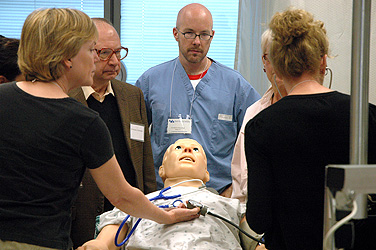News
Medical emergencies in the dental office

Dental professionals gather for a simulation designed to assess how they would react to a medical emergency in their dental office.
It’s 3 p.m. on a Friday and a middle-aged man sporting a gray Buffalo Bills T-shirt sits in a dentist’s chair. His appointment on this particular day is for a tooth that has been causing him considerable pain over the past several days.
The dental hygienist prepares him for a bite-wing X-ray. Shortly after she places the device in his mouth, he begins choking, then swallows the X-ray. He passes out. Immediately, Ann, the dental hygienist, springs into action, calling for a doctor’s assistance and for someone to dial 911. She begins administering CPR.
This powerful, realistic situation recently unfolded not in an actual dentist’s office, but in the Behling Simulation Center in Farber Hall on the South Campus.
It was part of a new immersion learning program for dental professionals conducted by the School of Dental Medicine’s Office of Continuing Dental Education to simulate the kind of medical emergency that could happen in their offices.
The workshop, attended by approximately two dozen dentists, dental assistants and hygienists, was led by Michael Hatton, clinical associate professor of oral diagnostic sciences in the dental school.
The prospects for the simulation center are enormous, not only for the dental school, but for each of UB’s health sciences schools.
“This is a whole different way of learning,” Hatton says of the center, which is built to resemble a hospital wing. “I think it’s going to revolutionize things we have difficulty measuring now.”
That includes assessing how health care professionals react in an emergency situation, when every second counts and there are myriad external events affecting the outcome. The Behling Simulation Center is designed to help students and medical practitioners better manage these situations using immersion learning.
“The usual route from teacher to student is one-way communication, with a few questions, and maybe students remember 20 to 30 percent,” Hatton explains. “This is a whole different style of learning: where the event becomes reality. It goes beyond learning-skills acquisition to skills employment in a realistic environment that mimics the real world in as vivid a way as I’ve ever experienced.”
Ann McClester, a dental hygienist at UB, was among the participants during the recent simulation.
McClester, a doctor and an assistant entered a room set up like a dentist’s operating room.
Meanwhile, in a separate room just down the hall, eight other practitioners watched the events unfold via a live feed projected onto a screen. As McClester and her group cared for the “patient”—a mannequin that can breathe, gasp and gurgle—a distraught relative of the patient (played by Hatton’s wife, Elizabeth, a family medicine physician) burst into the room, shouting, “What are you doing to my brother?” One of the assistants coolly asked her to calm down and leave the room.
When members of McClester’s group finished the exercise, they returned to the debriefing room, where Hatton explained what they did well and what could have been handled better—much like a football team breaking down film after a game.
McClester says the experience was both fun and enlightening. “More people ought to do this,” she says. “I’ve never had someone swallow an X-ray before, so to have it happen here was an unusual circumstance for me.” But the experience forced her and the group to act quickly, assess the situation and then provide the best response to resuscitate the patient.
UB’s Behling Simulation Center is the nation’s first simulation center that focuses on inter-professional collaboration and education for health care providers. Expansion of the center is ongoing over the summer. Once complete, the facility will occupy more than 10,000 square feet.
The center is used by students from all five of UB’s health sciences schools, as well as by outside groups. “It provides an interdisciplinary, interactive education, whereas we didn’t have that before,” Hatton says.

Reader Comments